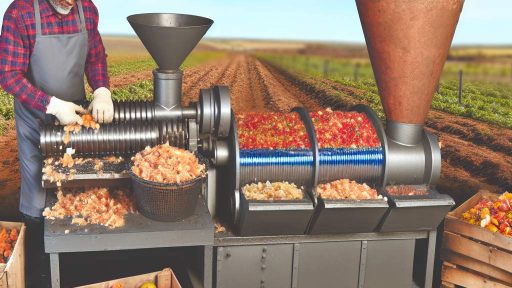Introduction to Community-Supported Agriculture and its Role in Biodiversity
Community-Supported Agriculture, or CSA, connects consumers directly to local farmers.
This relationship fosters a sense of community and shared responsibility.
Members typically pay upfront for a share of the harvest.
As a result, farmers gain financial stability and consumers get fresh produce.
The Concept of CSA
Community-Supported Agriculture originated in the 1980s in the United States.
It was inspired by similar movements in Europe and Japan.
This model promotes sustainable farming practices.
Moreover, it encourages consumers to support local economies.
Biodiversity in CSA
Biodiversity refers to the variety of plant and animal species in an environment.
CSAs often include a wide range of crops beyond just staples.
This variety can lead to greater resilience against pests and diseases.
Additionally, diverse ecosystems foster healthier soil and enhance productivity.
Benefits to Local Ecosystems
CSAs contribute positively to the local environment.
- They promote organic farming methods, reducing chemical usage.
- They enhance soil fertility through crop rotation and cover cropping.
- Furthermore, they support wildlife habitats by preserving natural landscapes.
Encouraging Sustainable Practices
Farmers involved in CSA are often more open to sustainable practices.
This includes using permaculture techniques and regenerative agriculture.
Transform Your Agribusiness
Unlock your farm's potential with expert advice tailored to your needs. Get actionable steps that drive real results.
Get StartedSuch practices help combat climate change and protect biodiversity.
Moreover, they lead to healthier food options for consumers.
Connecting Communities and Farmers
CSAs strengthen the bond between farmers and their communities.
Members often visit farms, fostering a deeper understanding of agriculture.
This interaction promotes transparency about food production.
Additionally, it encourages members to appreciate seasonal foods.
The Principles of CSA: Direct Farmer-Consumer Relationships
Understanding Community-Supported Agriculture
Community-supported agriculture, or CSA, fosters direct connections between farmers and consumers.
This model allows consumers to invest in local farms before the growing season begins.
As a result, farmers receive upfront capital to grow their crops.
In return, consumers receive fresh produce, often weekly, throughout the growing season.
The Benefits of Direct Relationships
Direct relationships cultivate trust and transparency in food production.
Consumers gain insight into how their food is grown.
Furthermore, farmers receive immediate feedback from their community.
This dialogue enhances the quality of produce and allows for tailored offerings.
Creating a Strong Community
CSA programs promote a sense of belonging and community among participants.
Members often engage in farm tours and community events.
These activities create opportunities for education about sustainable practices.
Additionally, they encourage community support for local food systems.
Value of Seasonal Eating
CSAs offer an opportunity to eat according to the seasons.
Members experience a variety of flavors and textures throughout the year.
Seasonal eating helps to support local ecosystems and biodiversity.
Moreover, it encourages consumers to explore new recipes and cooking techniques.
Challenges and Considerations
Despite numerous benefits, CSAs have their challenges.
Members must be flexible and adaptable to seasonal changes.
Showcase Your Farming Business
Publish your professional farming services profile on our blog for a one-time fee of $200 and reach a dedicated audience of farmers and agribusiness owners.
Publish Your ProfileAdditionally, it may require a willingness to try unfamiliar vegetables.
Farmers, on the other hand, must manage yield fluctuations due to weather and pests.
Benefits of CSA for Local Ecosystems and Biodiversity
Enhancing Local Biodiversity
Community-Supported Agriculture (CSA) directly supports local ecosystems.
It promotes the growth of diverse crops and plants.
This diversity attracts various pollinators and beneficial insects.
In turn, these organisms enhance agricultural productivity.
Healthy ecosystems rely on this complex web of life.
Soil Health Improvement
CSAs implement sustainable farming practices.
These practices improve soil quality and fertility.
Crop rotation is a common method used by farmers.
Crop rotation prevents soil depletion and encourages nutrient diversity.
Healthy soil retains moisture and reduces erosion.
Reduction of Chemical Inputs
CSAs often minimize the use of harmful pesticides and fertilizers.
Organic practices promote natural pest control methods.
This reduction fosters a healthier environment for all organisms.
Consequently, it leads to cleaner water bodies nearby.
Local Food Security
CSAs provide fresh produce directly to local communities.
This access strengthens local food networks and economies.
It reduces reliance on industrial food systems.
Additionally, local sourcing lowers transportation emissions.
Fresh food enhances community health and well-being.
Educational Opportunities
CSAs serve as educational platforms for sustainable practices.
They offer workshops and farm tours for community members.
Thus, they foster awareness about environmental stewardship.
This education encourages consumers to support local farmers.
As awareness grows, so does the commitment to biodiversity.
Delve into the Subject: Farm-to-Restaurant Programs for Direct Produce Sales
Case Studies: Successful CSA Models Promoting Biodiversity in Various Regions
Pacific Northwest: A Diverse Approach
In the lush landscapes of Oregon, Lavender Valley Farms thrives with Community-Supported Agriculture.
This farm combines organic practices with diverse crop production.
Members receive a variety of seasonal produce, including unique herbs and fruits.
Moreover, the farm implements crop rotation and cover cropping to enhance soil health.
Through these methods, Lavender Valley contributes significantly to local biodiversity.
Midwest Innovations: Integrating Livestock and Crops
Green Pastures CSA in Minnesota showcases an innovative integration of crops and livestock.
This model utilizes rotational grazing to improve soil fertility.
Additionally, it promotes natural pest control and enhances ecosystem services.
Members enjoy fresh fruits, vegetables, and ethically raised meats.
This holistic approach strengthens biodiversity within the farming system.
Southeast Strategies: Embracing Native Plants
Wildflower Meadows CSA in North Carolina emphasizes the cultivation of native plants.
These plants support local pollinators and wildlife, enriching the ecosystem.
Members receive seasonal shares of both cultivated and wild edible plants.
Showcase Your Farming Business
Publish your professional farming services profile on our blog for a one-time fee of $200 and reach a dedicated audience of farmers and agribusiness owners.
Publish Your ProfileBy incorporating native species, the farm enhances regional biodiversity.
Further, education programs inform the community about the importance of preserving these plants.
Northeast Connections: Community Engagement and Biodiversity
At Riverbend CSA in New York, community engagement is a central focus.
This model involves local volunteers in farm activities throughout the growing season.
Additionally, the farm promotes biodiversity by growing a wide range of vegetable varieties.
Members learn about sustainable farming practices and the value of biodiversity.
Through workshops and events, Riverbend fosters a strong connection to local ecology.
Desert Agriculture: Adapting to Arid Environments
Desert Oasis CSA in Arizona exemplifies successful farming in arid conditions.
This CSA employs water-efficient irrigation methods to maximize growth.
Moreover, it cultivates drought-resistant plant varieties.
Members benefit from a fresh array of produce, even in challenging climates.
This approach highlights the adaptability of our food systems while preserving vital biodiversity.
Gain More Insights: Biodiversity in Farming for Supporting Beneficial Insects
Challenges Faced by CSAs in Supporting Biodiversity in Agriculture
Understanding Community-Supported Agriculture
Community-supported agriculture connects farmers directly with consumers.
This model fosters local food systems and enhances community ties.
CSAs help promote diverse crops and sustainable farming practices.
Economic Pressures
Economic pressures often threaten the viability of CSAs.
Many farmers struggle to maintain profitability in the current market.
High input costs for seeds and equipment can limit biodiversity efforts.
Furthermore, competition from industrial agriculture creates additional stress.
Resource Limitations
Many CSAs face resource limitations impacting biodiversity initiatives.
Water scarcity poses significant challenges for crop diversity.
Additionally, limited access to land restricts expansion opportunities.
Many small farms also lack the funds for innovative farming techniques.
Consumer Demand and Engagement
Consumer preferences can influence the types of crops grown.
Some consumers prioritize appearance over biodiversity in produce.
This tendency leads farmers to grow fewer, more commercially viable options.
Moreover, educating consumers about biodiversity remains crucial.
Climate Change Effects
Climate change poses severe threats to agricultural biodiversity.
Shifting weather patterns disrupt traditional planting schedules.
Additionally, extreme weather events can devastate crops suddenly.
Farmers must adapt practices to sustain diverse ecosystems.
Policy and Regulatory Challenges
Regulatory challenges can hinder CSA growth and biodiversity goals.
Pervasive regulations may limit the ways farmers can innovate.
Additionally, subsidies often favor monoculture farming practices.
Many CSAs struggle to navigate complex agricultural policies effectively.
You Might Also Like: Beneficial Insect Habitats: A Guide To Boosting Biodiversity On US Farms

Consumer Involvement in Biodiversity Efforts Through CSA Memberships
Understanding Community-Supported Agriculture
Community-Supported Agriculture (CSA) connects consumers directly to local farms.
This model allows consumers to purchase shares of a farm’s harvest.
Consequently, this direct relationship fosters a sense of community.
Showcase Your Farming Business
Publish your professional farming services profile on our blog for a one-time fee of $200 and reach a dedicated audience of farmers and agribusiness owners.
Publish Your ProfileMoreover, it enhances awareness about sustainable food systems.
Supporting Diverse Farming Practices
CSA members play a critical role in biodiversity efforts.
They support farms that prioritize ecological health and diversity.
By choosing to join a CSA, consumers directly influence farming practices.
For instance, farms may choose to grow heirloom varieties or organic crops.
Ultimately, this drives a demand for more cultivated plant species.
Promoting Local Economies
Supporting local farms boosts regional economies.
Consumers investing in CSAs keep financial resources within their communities.
This engagement leads to job creation and economic stability.
Additionally, it helps maintain farmland and open spaces.
Enhancing Environmental Awareness
CSAs encourage consumers to learn more about their food sources.
Members often participate in farm activities and events.
This interaction cultivates a deeper understanding of agriculture’s impact.
Furthermore, it promotes responsible consumption and environmental stewardship.
Building Stronger Community Bonds
CSA memberships foster connections among consumers and farmers.
By sharing experiences and stories, members create community bonds.
As a result, consumers are more engaged in local food systems.
These connections lead to mutual support and collaboration.
Encouraging Feedback and Innovation
CSAs thrive on consumer feedback to improve offerings.
This dialogue leads to innovation in farming methods and product variety.
Farmers can adapt their practices based on consumer preferences.
This responsiveness promotes a dynamic agricultural environment.
Cultivating Future Generations
CSAs educate younger generations about food production.
Families involved in CSAs often share resources and knowledge.
This education helps instill appreciation for biodiversity and farms.
Ultimately, it inspires long-term commitment to sustainable practices.
Find Out More: Food Waste Reduction Benefits for Regenerative Farming Systems
Future Trends: How CSA Can Adapt to Enhance Biodiversity in American Farms
Embracing Diverse Crop Cultures
CSA programs can promote the cultivation of diverse crops.
This practice encourages biodiversity on farms and within local ecosystems.
Farmers can experiment with heirloom varieties that enhance resilience.
They should collaborate with local seed banks for greater access to seeds.
Moreover, consumer education plays a crucial role in embracing these options.
Integrating Livestock with Crop Production
Integrating livestock into crop production offers multiple benefits.
This method helps in pest control and nutrient management.
Additionally, it promotes natural soil fertility and reduces reliance on artificial fertilizers.
CSAs can develop programs that include eggs, dairy, or meat along with vegetables.
Such efforts can create a more sustainable food system.
Implementing Agroforestry Practices
Agroforestry incorporates trees and shrubs into farmland.
This practice enhances biodiversity by providing habitats for various species.
CSAs can utilize agroforestry to improve their farm ecosystems.
Showcase Your Farming Business
Publish your professional farming services profile on our blog for a one-time fee of $200 and reach a dedicated audience of farmers and agribusiness owners.
Publish Your ProfileIt contributes to better soil health, water conservation, and climate resilience.
Additionally, farmers should explore silvopasture systems for integrated farming.
Utilizing Technology for Biodiversity Monitoring
Technology can significantly aid in monitoring biodiversity.
Farmers can use drones to assess crop diversity and health.
This data helps in making informed decisions for management practices.
Furthermore, mobile applications can educate consumers about biodiversity.
They can track which crops are being grown and their benefits.
Participating in Local Conservation Efforts
Engaging in local conservation initiatives can foster community ties.
CSAs should partner with environmental organizations for such efforts.
Participating in workshops can create awareness about biodiversity.
Additionally, community involvement can lead to successful habitat restoration projects.
These collaborations enhance not only biodiversity but also community resilience.
Enhancing Consumer Engagement in Biodiversity
Consumers play a vital role in promoting agricultural biodiversity.
CSAs should encourage members to participate in farm activities.
Workshops can educate consumers about the importance of biodiversity.
Furthermore, offering farm tours can increase transparency and connection.
This engagement fosters a sense of community and commitment to biodiversity.
Policy Implications: Supporting CSAs to Foster Biodiversity at a National Level
Importance of Policy Frameworks
Effective policy frameworks support the growth of Community-Supported Agriculture (CSAs).
These frameworks encourage farmers to adopt biodiversity practices.
Furthermore, they create incentives for sustainable farming methods.
Policies should prioritize funding for local and organic farming initiatives.
Additionally, they need to address the economic viability of small farms.
Encouraging Partnerships
Partnerships between CSAs and government organizations can drive change.
These collaborations can enhance local food systems.
For instance, partnerships can facilitate access to necessary resources.
Networking between CSAs promotes shared knowledge and best practices.
Subsequently, these partnerships can amplify collective farmer voices.
Grant Programs and Financial Support
Federal and state governments can offer grant programs to support CSAs.
These financial resources can help mitigate start-up costs for new farms.
Moreover, grants can fund training for farmers in sustainable practices.
Investing in CSAs ensures a diverse agricultural landscape.
Education and Outreach Initiatives
Education plays a vital role in promoting CSA benefits to communities.
Public outreach initiatives can raise awareness about local food systems.
Workshops can provide information on growing biodiversity on farms.
Additionally, educational initiatives can strengthen community connections.
Regulatory Support for Biodiversity
Establishing regulations that protect biodiversity is crucial.
These regulations can limit harmful agricultural practices.
Support for organic certification processes enhances farm sustainability.
Moreover, policies should promote native species preservation in farming.
Measuring Impact and Success
Implementing metrics to assess the impact of CSA policies is essential.
Showcase Your Farming Business
Publish your professional farming services profile on our blog for a one-time fee of $200 and reach a dedicated audience of farmers and agribusiness owners.
Publish Your ProfileRegular evaluations inform future policy adjustments and improvements.
These assessments can demonstrate the value of CSAs in biodiversity efforts.
Furthermore, success stories can inspire broader adoption of CSAs.
Additional Resources
Harmony in Diversity: Harnessing Food Biodiversity to Combat …




